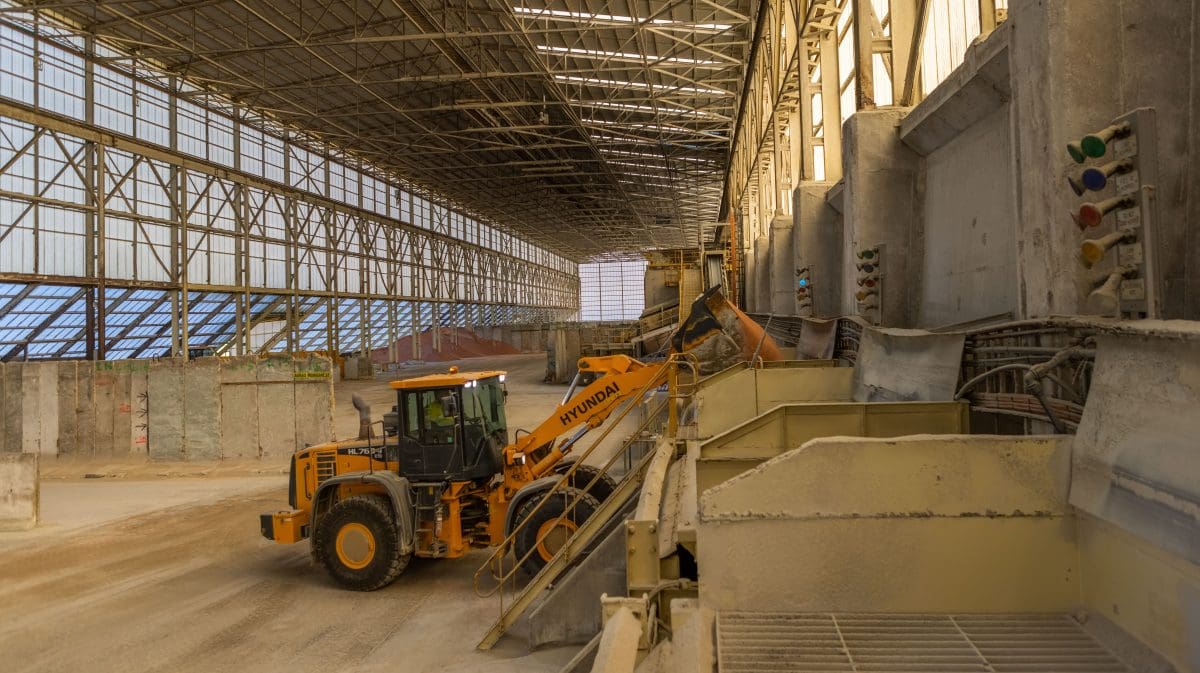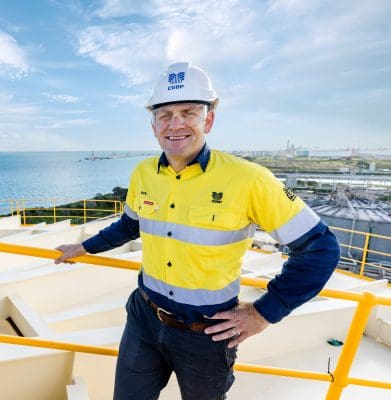
Fertiliser is moving from distribution centres including CSBP’s Esperance site to farms ahead of seeding. Photo: CSBP
THE annual surge in fertiliser sales is off to a delayed start as growers decide they have waited as long as they can to see further price falls ahead of winter-crop planting.
Soil testing is also under way to determine what type of fertiliser is needed to get the 2023-24 crop off to a good start following what for most was a bumper harvest.
While fertiliser prices have fallen around 25pc from their peak last year, they are still well above the long-term average, but with grain prices holding up, sources expect growers will not limit their inputs based on cost.
WA supply chain ready
In Western Australia, CSBP Fertilisers general manager Mark Scatena said despatches of seeding fertilisers have been slower than previous seasons.
“The late finish to the WA harvest means that some growers are still taking a summer break, and transport infrastructure remains engaged in the task of moving successive record crops, as well as lime,” Mr Scatena said.
CSBP Fertilisers is expecting peak demand for seeding fertiliser in March-April, with despatches in the Geraldton Zone at the front end to accommodate its earlier seeding window.
He said growth in WA grain production over the past decade has seen demands on storage and transport infrastructure increase.
This, plus a trend towards earlier seeding, has led to compression of the timing window for fertiliser despatch.
“The past two seasons of elevated grain production mean that a large amount of on-farm storage is occupied with grain, and so we expect there may be less storage than normal available for fertiliser.
“This will likely contribute to a ‘peakier’ demand profile, and we are communicating closely with customers in an effort to manage this.”
The advent of liquid urea ammonium nitrate (UAN), in CSBP’s case branded as Flexi-N, has widened the supply chain for seeding fertiliser.
“The WA market is unique in terms of the storage capacity for liquid fertiliser that has been developed on-farm over the past 20 years.
“We certainly expect Flexi-N tanks will be full ahead of seeding, and are working closely with the industry to support this preparation.”
“The development of a parallel liquid transport, storage, and despatch supply chain has taken pressure off the supply chain for granular fertiliser.
“This has helped ensure WA growers have access to the nutrients required to support crop establishment.”
Price drops
The softening price outlook in the lead-up to seeding is in sharp contrast to this time last year, when Russia’s invasion of Ukraine on February 24 saw prices shoot up.
“This time last year the Russian invasion of Ukraine had begun, impacting gas availability, fertiliser production economics and hence global trade flows.
“In addition, fertiliser availability was also impacted due to sanctions and tariffs on the key producing regions of Russia and Belarus, which ultimately drove prices materially higher.”
Mr Scatena said the milder winter in northern Europe and re-establishment of gas access for European fertiliser manufacturers has allowed prices to drift lower.
Other factors contributing to a softening in the market include fertiliser’s exclusion from tariff and sanction regimes in North America and Europe in view of food security concerns, and the resumption of exports from China.
“These factors have all contributed to a partial rebalancing of fertiliser trade flows, and hence some lowering of prices.
“Relative to this time last year, pricing for key products such as urea and UAN have fallen approximately 40pc and 23pc respectively from the very high prices of last year.”
In commentary released January 17, Episode 3 analyst Andrew Whitelaw said gas prices have fallen in recent months from recent highs because Europe has so far had a relatively mild winter, thus reducing demand for natural gas as the major input for urea.
“The price of urea in the Middle East has come under considerable pressure, dropping to A$645/t on average for the month.
“This is great news for Australian producers, as this time last year it was $1090.
“The big question now is whether this fall in price will be passed on to producers.”
Testing, testing
Mr Scatena said the late finish to harvest has led to a slower start to the soil-testing season, but samples were now arriving and being processed in large volumes at the CSBP Lab.
He said the continued growth in demand from growers for nutritional data and analysis was a key driver of recent productivity improvements observed in WA.
“Our analysis indicates that the large yields and record crop production achieved by growers in WA over recent seasons have resulted in more nutrient being removed in grain than has been applied via fertiliser in many areas of the state.
“Potassium and nitrogen removal rates in the north-eastern wheatbelt are areas of particular imbalance.”
Looking back
Across Australia, consensus is that some crops were underfertilised.
In South Australia’s case, it was because the season started dry, and with a modest yield outlook, or because conditions got too wet, as was the New South Wales experience.

CSBP general manager Mark Scatena at the company’s facility at Kwinana, WA. Photo: CSBP
High fertiliser prices in all states deterred some growers from top-dressing as much as they would have had fertiliser been cheaper.
Disease pressure was also intense across much of the Australian grainbelt, and some growers opted to apply fungicide rather than fertiliser in the limited windows they had to do fieldwork between rain events.
“Last year we did see scenarios where growers considered applying additional nitrogen to take advantage of favourable conditions, but held back to mitigate downside risk.
“Had nitrogen prices been lower, we expect that growers would have been more inclined to ‘play the season’ more than they did through additional applications of nitrogen.”
Rolling in Victoria
At Pearsons Group’s Swan Hill Stockfeeds, store manager Liam Barry said buying of fertiliser was running several weeks behind schedule after a prolonged harvest followed by a delayed holiday for many, and growers were only now turning their attention to fertiliser needs.
“Normally a lot would have bought fertiliser by now; in years gone by, we’ve sold it in November-December for pick-up in February-March,” Mr Barry said.
“It’s been a reasonably slow start for fertiliser; the price has been coming back and they’ve been hoping to get the best price now.”
He said soil testing was usually done in February, and is on track for the same this year ahead of the start of dry sowing of mainly barley and canola crops as early as late March.
Growers are expected to follow the pattern for February-March buying with MAP, Granuloc with 1pc zinc, and urea at the top of the list.
Pearsons also runs a fleet of trucks and four up-country sites, so is able to backload fertiliser on its runs to port.
“We’ve got trucks going to Melbourne every day, and since harvest has finished, trucks in general have been too hard to organise.”
Unknowns in NSW
NSW crops which escaped waterlogging/and or flooding were in the minority last year, and Delta Ag Moree agronomist Rob Long said the wet year has likely impacted nitrogen reserves in the soil.
“A number of growers chose not too to pursue the top-end (yield) potential, partly because of the risk of flooding and partly because of the cost of top dressing, and partly because of the availability of urea,” Mr Long said.
NSW suffered some major headaches due to rain and flooding which impacted port operations and road transport as well as fieldwork.
“It was a difficult year to get N right.”
Denitrification occurs when bacteria converts soil nitrate into nitrogen gases that are lost from the soil, and when soil is nearing saturation and oxygen has become limited.
Mr Long said the extent of denitrification is the “unknown” for crop nutrition this season.
“We’re in the middle of soil testing now.
“We would expect soil nitrate levels to be relatively low because of denitrification and a couple of big growing years.
“We’ve had two wet seasons and a wet spring, and generally farmers will step back into N applications more judiciously this year based on soil-test results.
“Grain prices are still good, N prices have come back, and it looks like it might be an easier to manage.
“Supply lines look good too.”
Grain Central: Get our free news straight to your inbox – Click here

HAVE YOUR SAY